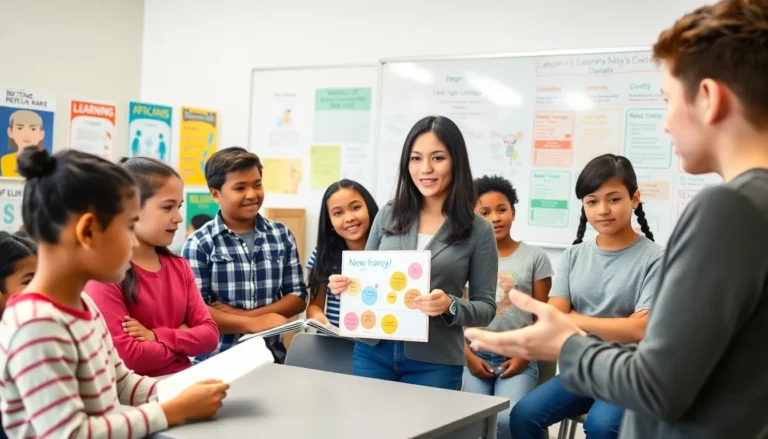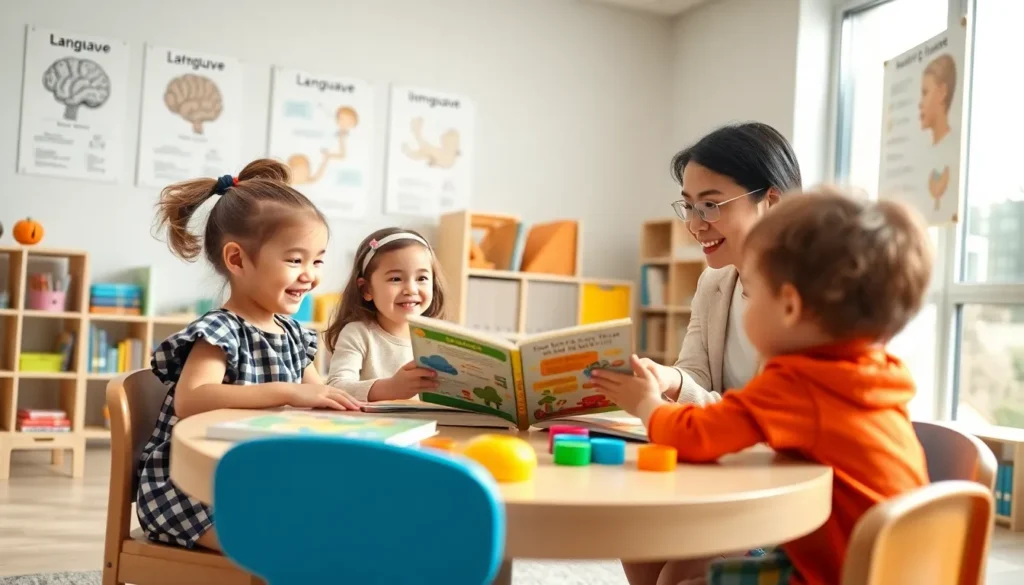Table of Contents
ToggleEver found yourself pondering how toddlers can turn “goo-goo ga” into eloquent sentences faster than you can say “language acquisition?” Welcome to the intriguing realm of language development theories. It’s a bit like watching a magician pull a rabbit out of a hat, only instead of a rabbit, you get a delightful conversation. In this text, we will peel back the layers of these theories, exploring behaviorist, cognitive, and social interactionist perspectives. Buckle up: we’re about to jump into the captivating journey of how we learn to express ourselves.
Overview Of Language Development Theories

Language development theories are plentiful, each striving to explain that enigmatic transition from babbling to fluent speech. At the heart of this discussion are primarily two influential theories: Behaviorist Theory and Cognitive Development Theory.
Behaviorist Theory
Behaviorism, a term often thrown around in psychology, suggests that language acquisition happens primarily through conditioning. B.F. Skinner, a pivotal figure in behaviorist thinking, proposed that children learn language by imitating adults. Think of it as a series of reinforcements, when a child says the word “milk” and receives that delightful glass of milk in return, the child learns that certain sounds yield certain outcomes.
Cognitive Development Theory
In contrast, the Cognitive Development Theory, championed by Jean Piaget, posits that language development is intertwined with cognitive growth. Children don’t just mimic: they construct language based on their understanding of the world around them. They observe, think, and then speak. Hence, as a child’s cognitive abilities expand, so too does their ability to form more complex sentences. If behaviorist theory is like a parrot mimicking its owner, cognitive development theory is akin to a child weaving words into stories based on their experiences.
Social Interactionist Theory
While the former theories have their merits, they sometimes fall short of capturing the rich social tapestry that influences language acquisition. Enter the Social Interactionist Theory, where the magic of language emerges through social interactions.
Role Of Environment In Language Acquisition
Consider the environment surrounding a child. It’s not just the presence of language but the interaction and communication within that environment that fosters language skills. Children exposed to rich language environments tend to develop better language skills. It’s like placing a seed in fertile soil: the more nutritious the environment, the more significant the growth.
Influence Of Social Interaction
Also, social interaction plays a vital role. In Vygotsky’s perspective, language is a tool for social engagement. Interacting with parents, peers, and caregivers provides children with opportunities to learn new vocabulary and language structures. The back-and-forth conversations allow children to practice and refine their linguistic skills, making language learning a collaborative venture.
Challenging Theories And Perspectives
Even with a solid foundation of theories, doubts remain. Each approach faces critiques, notably Behaviorism.
Critiques Of Behaviorism
Critics argue that behaviorist theory oversimplifies language acquisition. It ignores the richness of human cognition and the emotional context in which language is used. Children often produce sentences they’ve never heard before, suggesting there’s more than mere imitation at play. They showcase creative language use, indicating that language learning can’t be reduced to mere behavior responses. Also, any parent will tell you that sometimes, the more a child hears a word, the less likely they are to use it, a clear battle against the behaviorist perspective.
Emerging Theories And Research
As research continues to evolve, new theories are emerging to bridge the gaps left by traditional perspectives. The modern landscape of language development is characterized by an increasing understanding of the interplay between various factors.
Implications For Education And Teaching Methods
What does this mean for education? It suggests that educators should embrace interactive and socially engaging teaching strategies. Incorporating play-based learning and fostering group discussions can enhance language skills effectively. By recognizing that language is not just a series of sounds but a powerful tool for communication and expression, teachers can create environments that resonate with children’s natural inclinations to connect and converse.







